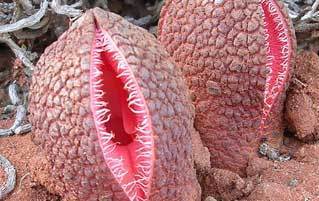7 Creepy Plants That Shouldn't Exist (Part 2)

Oh god, it finally happened: You accidentally stumbled outside. This is where nature keeps all the terrifying snakes, spiders, and spider-snakes we've been telling you about for years. Quick, look around: Do you see any animals? If so, just run. Soil yourself -- they might not like the taste. Oh, it's all clear? What about plants? Don't laugh, plants can be every bit as soul-scarring as animals. Anything touched by the sinister hand of Mother Nature is not to be trusted. Evidence:
The Sundew

That's Drosera glanduligera, and it doesn't seem too bad. Until you see it in action.

This is at five times normal speed. The plant moves slowly so the full horror of the fly's imminent death has time to sink in.
The sundew feeds on any insects unfortunate enough to step on those leaves you (barely) see around the edges of the plant. The leaves are spring-loaded and shaped so that they fling the insect directly into the center. Where a nest of sticky tentacles awaits. The tentacles then unfurl like a vegan hentai flick and physically pull the insect to its doom.

"Bet you can't eat just one!"
It is a real-life goddamn Sarlacc. And in case you were wondering: Yes, obviously this thing is from Australia.
Dead Man's Fingers

Xylaria polymorpha is what happens when the characters from Plants vs. Zombies decide to put aside their differences and start boning. Appropriately known as dead man's fingers, this fungus hands down (sorry) wins the award for "most likely to crawl out of the ground and strangle your family in the middle of the night."

Strangle if they're lucky.
Please note that, due to its fungal nature, Xylaria polymorpha feeds on dead and decaying matter, so don't turn to your buxom hiking date and be all, "Don't worry, that's just a fungus. There are no corpses here." Because you know the corpses are totally just waiting for you to say that so they can jump out at the most perfectly ironic moment.
Monkey Orchids

And now, here's a monkey ripping through space-time, about to lunge for your throat through the portal between worlds.
Or it's a flower that kind of looks like a different thing. Whatever -- we prefer the narrative of Dr. Monkiarty, arch-villain from the Primate Dimension.
Monkey orchids are found in the rainforests of Ecuador and Peru. For whatever reason, they're also known as Dracula orchids, because whoever's in charge of naming South American plants has never met a goddamn Dracula, apparently.

Based on Vlad the Impaler's lesser-known brother, Igor the Poo-Flinger.
Seriously, you saw a whole fleet of Imperial Shuttles with monkey faces and you thought "vampire"? You're fucking fired, Arturo.
No, we don't care that you have kids.
Well, you should've thought of that before you failed to come up with "Imperial Monkeyship Orchids," or whatever.
Hooker's Lips

Few things are more unnerving than a human body part just dangling from a branch in front of your face. But when said body parts are wearing goddamn makeup and making kissy faces at you, well, that's when nature is clearly just fucking with you before she sends the wolves in.
Psychotria elata is native to South American countries such as Colombia, Ecuador, Costa Rica, and Panama. However, few locals refer to it by its scientific name. Instead, they prefer to call it hooker's lips, because, well, look at it. The bright red color and pouty-lipped shape of the flowers are actually meant to attract pollinators such as hummingbirds. Apparently women wearing red lipstick in hummingbird country are in danger of choking on tiny birds mistaking their mouths for food sources.

Rolling Stones albums are not placed near windows to save on bird-corpse disposal.
Bloodwood Tree

One day, Mother Nature decided to let Freddy Krueger design a plant. This is what we got:

No Hexxus in here!
Looks pretty normal, right? Ain't a tree we met yet could stand up to our ax. Hell, let's chop it down right away to show it who's boss.

"Oh god, oh god, there's so much blood!"
*slap*
"Hold it together, man! Nobody knew that tree, we'll just make it disappear!"
It bleeds! What have we done? Did ... did we just accidentally kill an Ent, and holy shit how fucked are we if we did?
That's just how Pterocarpus angolensis rolls. It's commonly known as the bloodwood tree because, well, that's exactly what you'd call it too. This curiously red-sapped plant is found in Southern Africa and also David Lynch films. Here's a dude hacking at one with a machete.
All right, so now we know what kind of wood they used to build the lodge in The Shining.
Jew's Ear

Well, here's something you'd expect to find growing in Ted Bundy's backyard. Auricularia auricula-judae is a common black fungus found in many parts of the world. In Europe, it is commonly known as Jew's ear, because, well, that's what you'd call it too -- if you were an anti-Semite or suffering from some form of kosher pareidolia.
The unfortunate name stems from the fact that this thing usually grows on elder trees, and Judas supposedly hung himself on one. Since Judas was Jewish it didn't take too long for good ol' bigotry to show up and ask where the party's at. The Nazis used them in anti-Jewish propaganda, and they were commonly thought to be dangerous -- not because of any ill effects from actually consuming them but because of the association with Jewish people. You know, before today, we wouldn't have said mushrooms could be racist. But to paraphrase the great Ian Malcolm: "Hate finds a way."

"They were so preoccupied with whether they could be douchebags that they didn't stop to think if they should."
Hydnora Africana

Looking for all the world like a cross between the monster from Little Shop of Horrors and the chestburster from Alien, Hydnora africana is the closest thing we have to a real-life piranha plant.

So far, only Italian-American plumbers have been able to kill one.
Adding to the chestburster cred, the plant is also a shameless parasite. It doesn't have any leaves for photosynthesis, preferring instead to suck nutrients from nearby host plants, because who's going to tell it to stop? It also releases a terrible rancid odor that attracts dung beetles. It then traps them in its "jaws" until they're thoroughly coated with pollen and ready to be released. This process takes several days, during which the beetle is trapped inside that horrible-looking maw. And that's why this is Buffalo Bill's favorite flower.
Hydnora africana actually manages a few different levels of horror, depending on the angle you view it from. Here it is, looking for all the world like a sandworm fucked a cantaloupe.

"You have to squeeze it and feel for the sense of inescapable doom for all mankind to know it's ripe."
And here it is, looking like ...

Noooooooooooope.
We hate you, Nature.
Kel Zhang writes sciency stuff for Cracked when he's not trying to blow up the universe with his army of robot monkeys. Follow him on Twitter!
